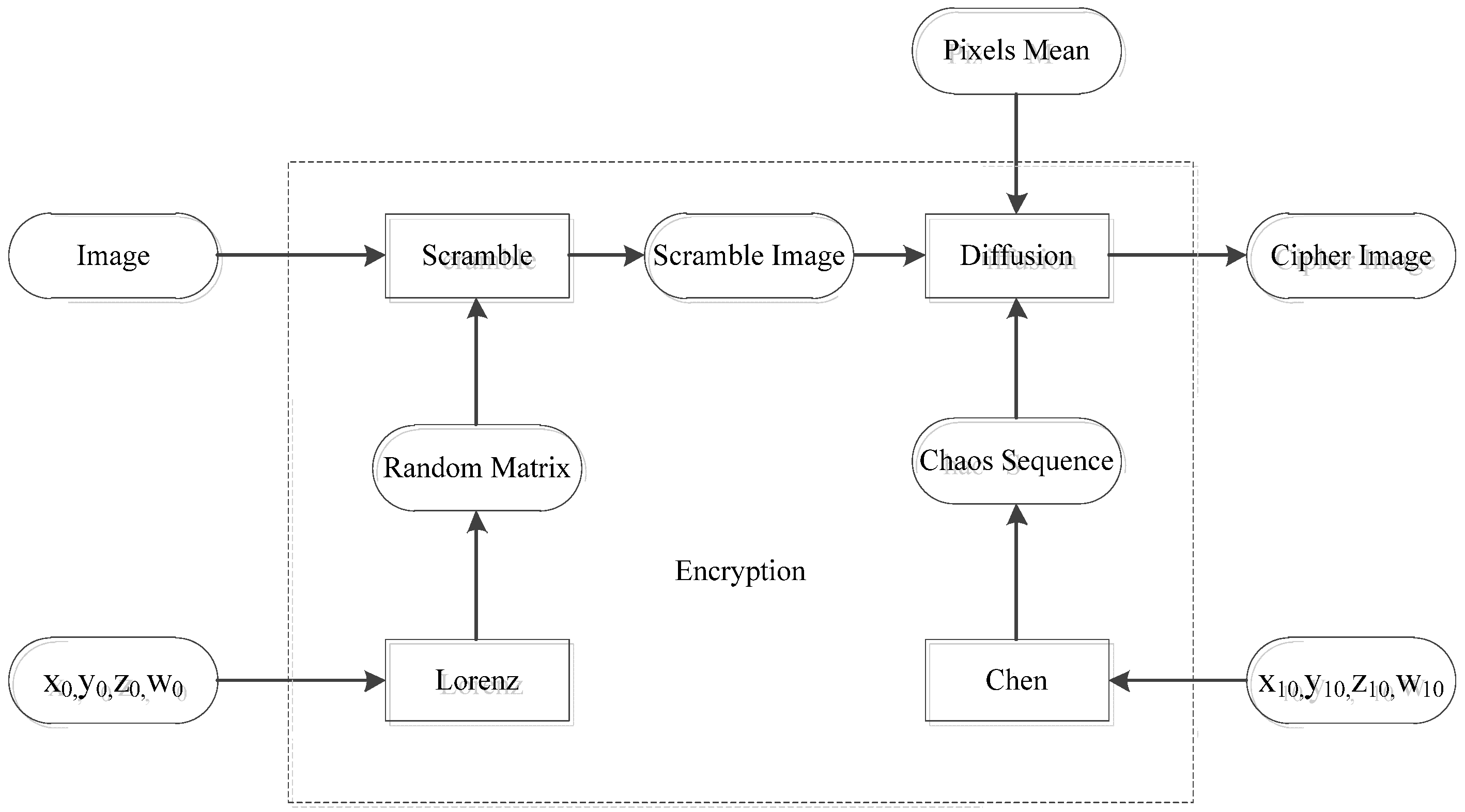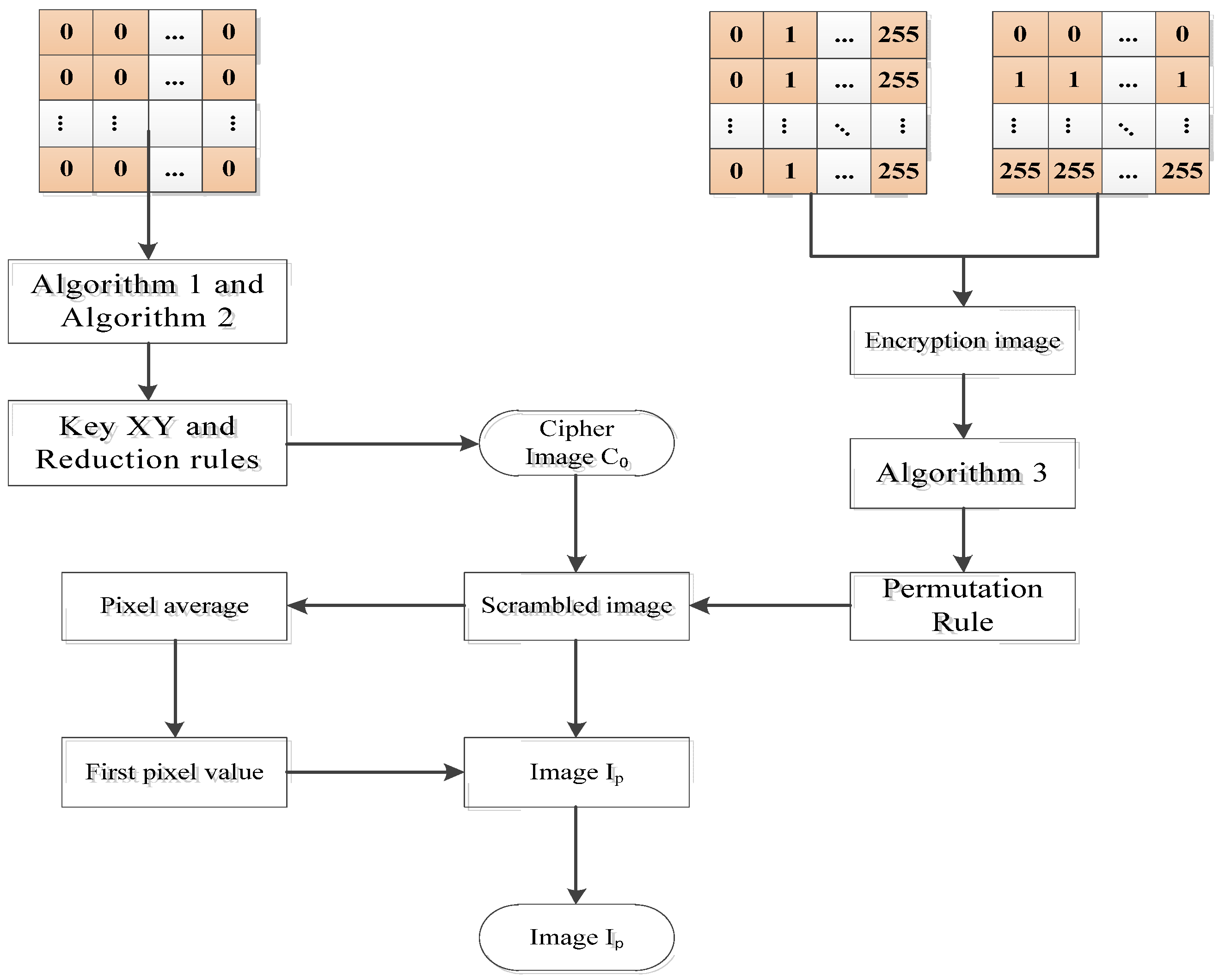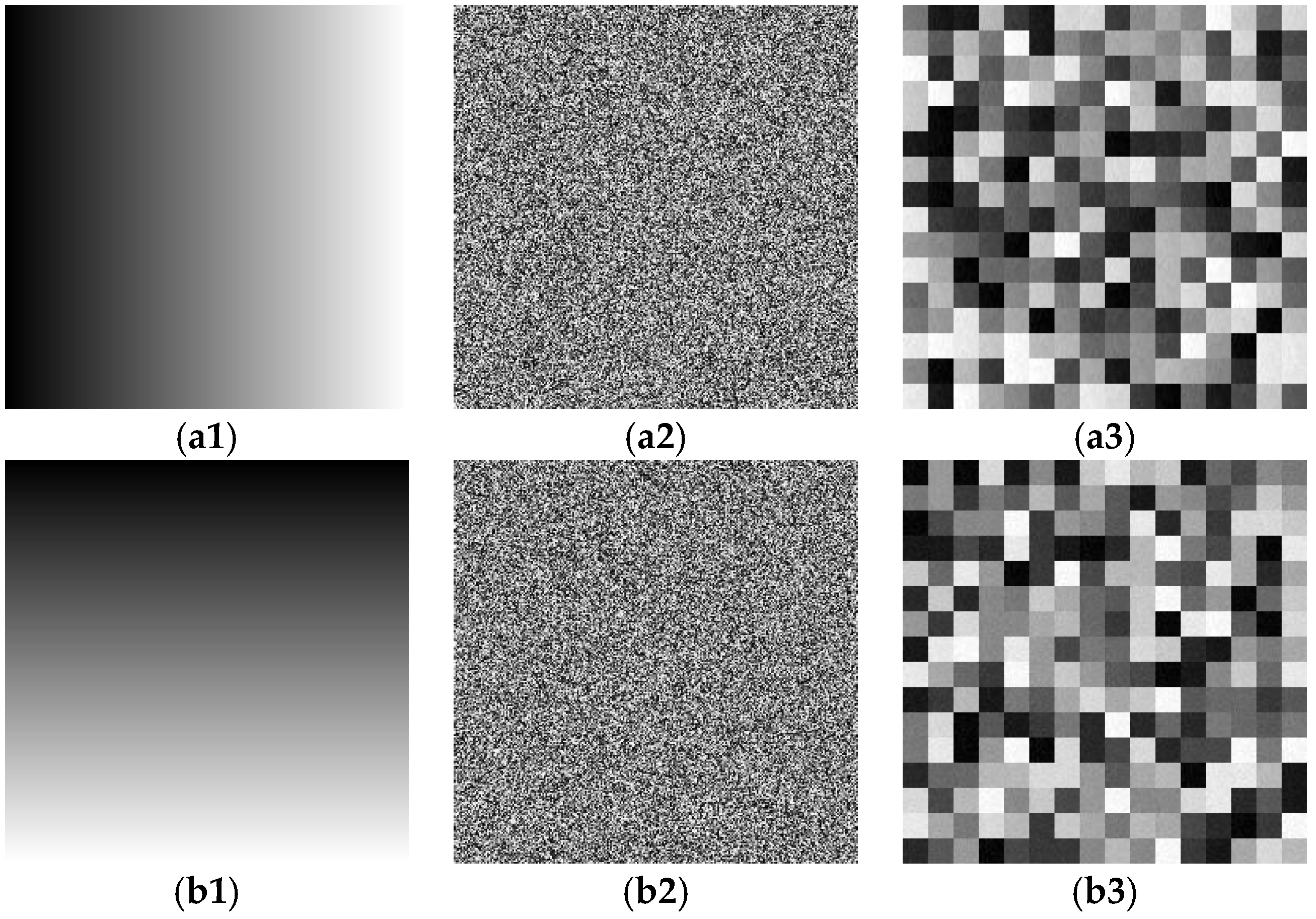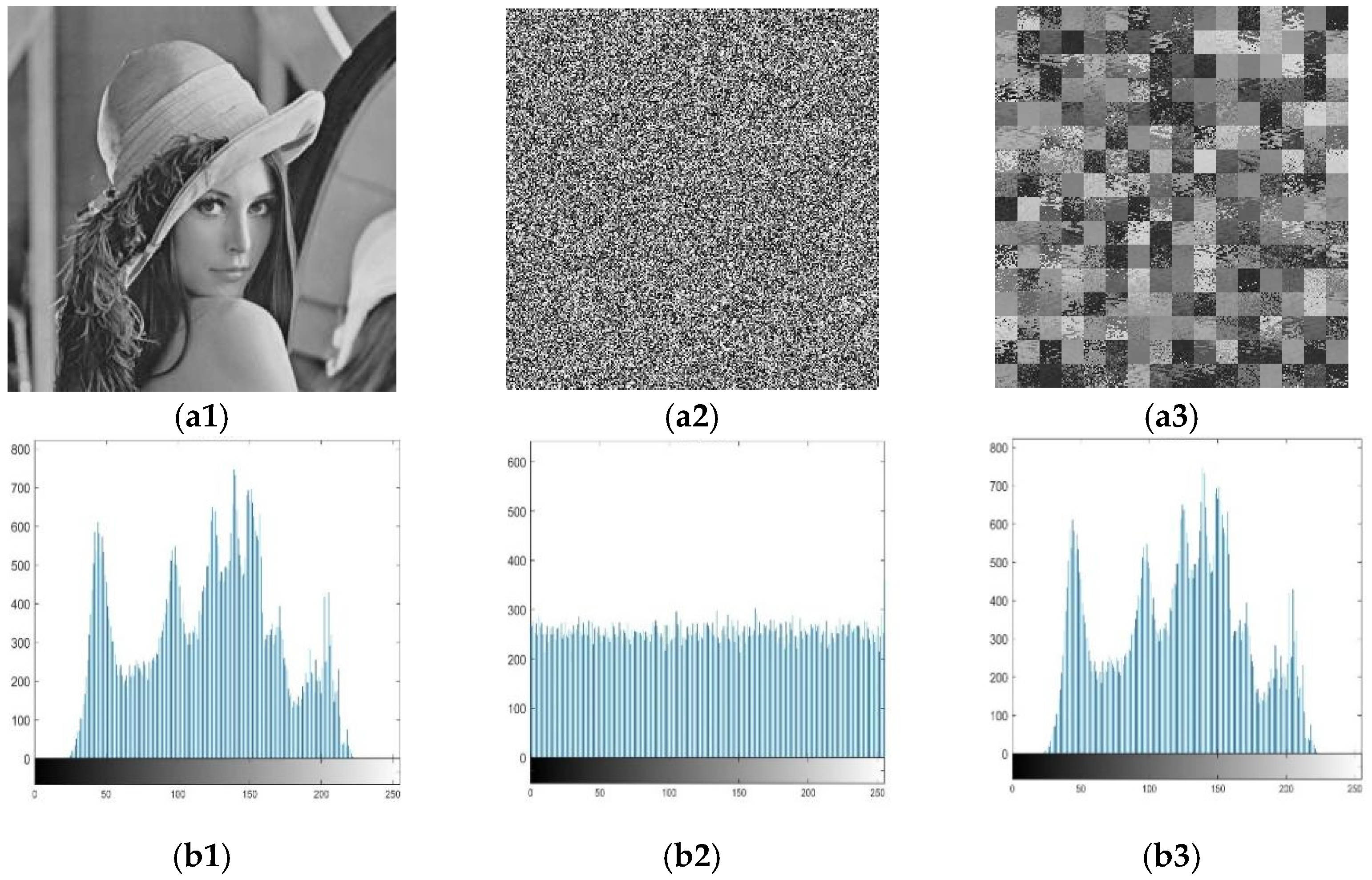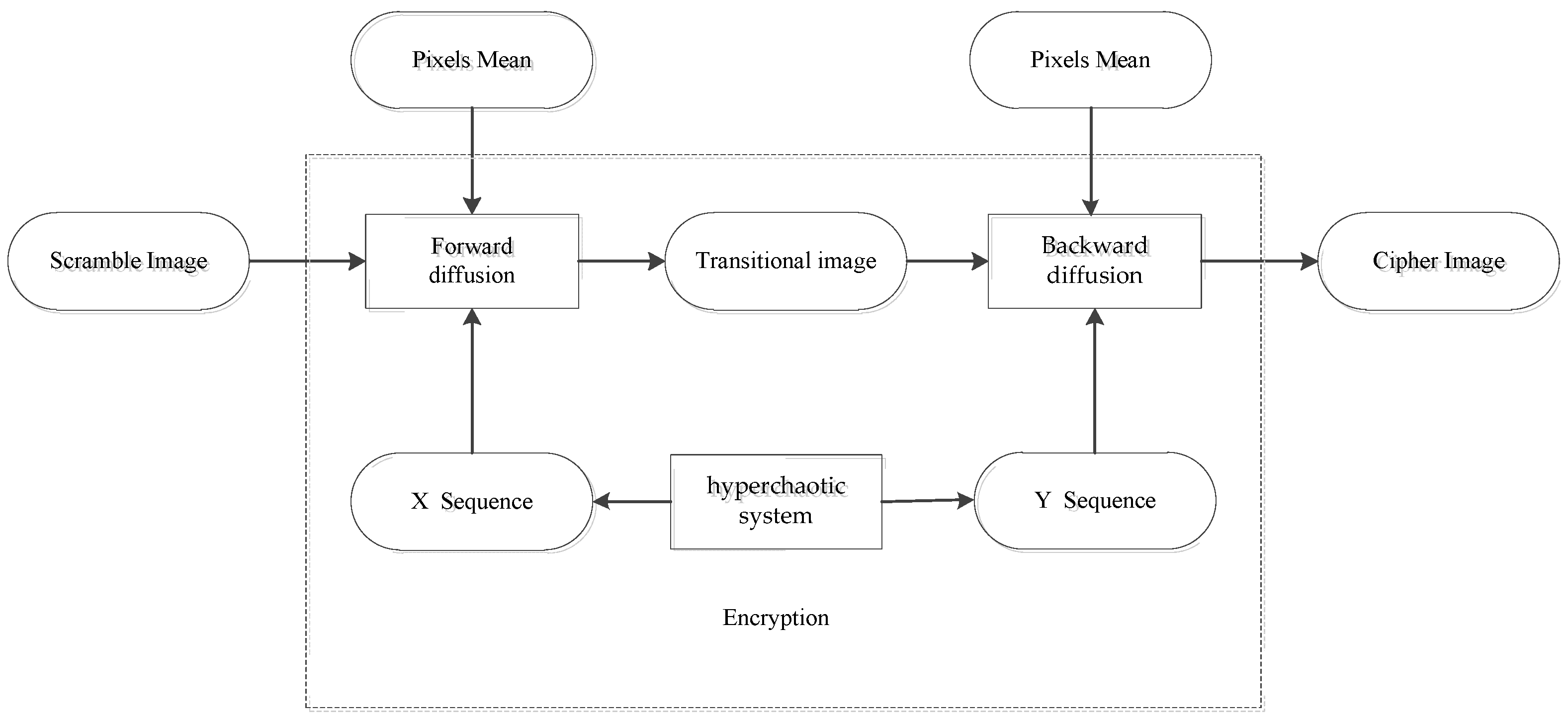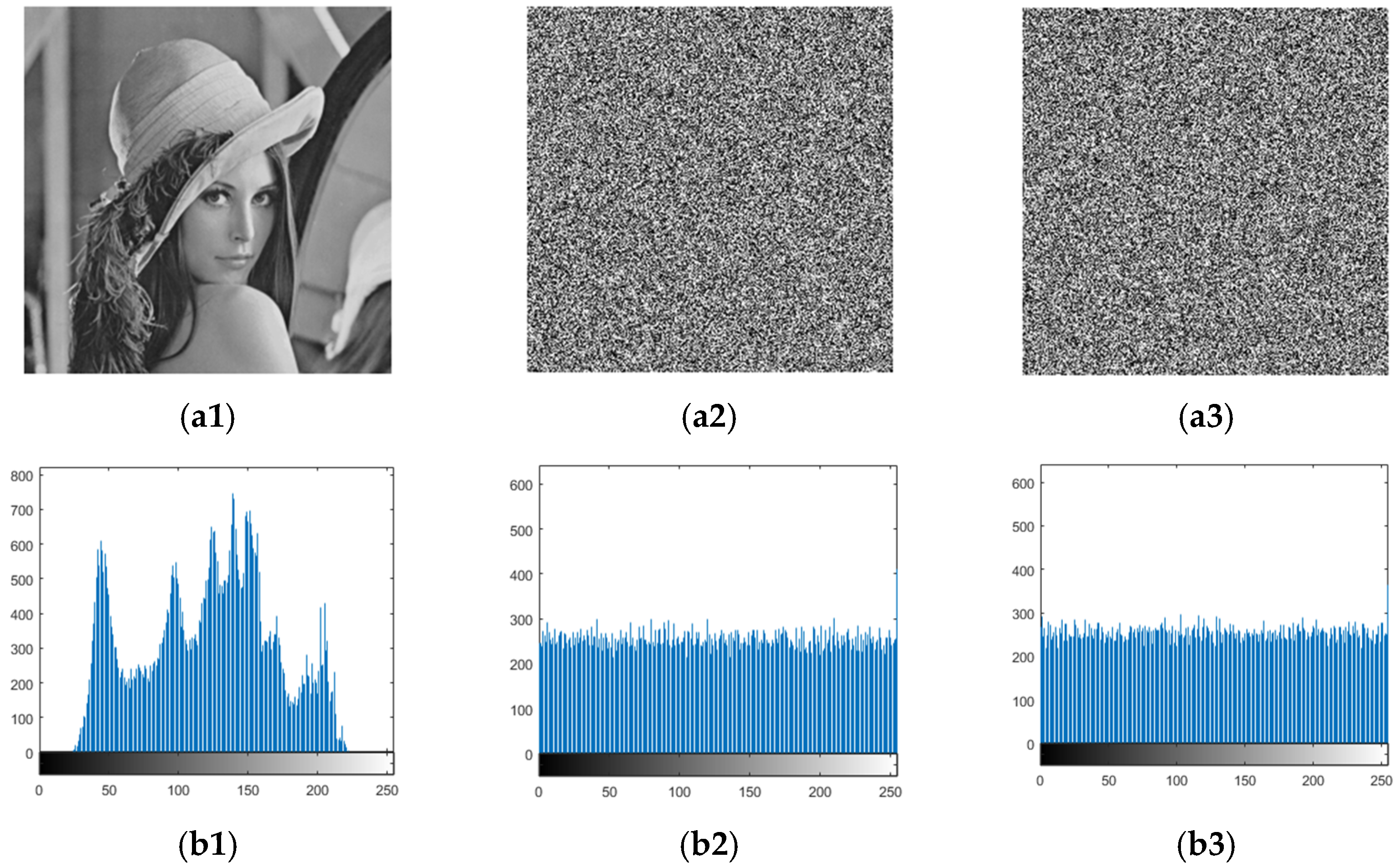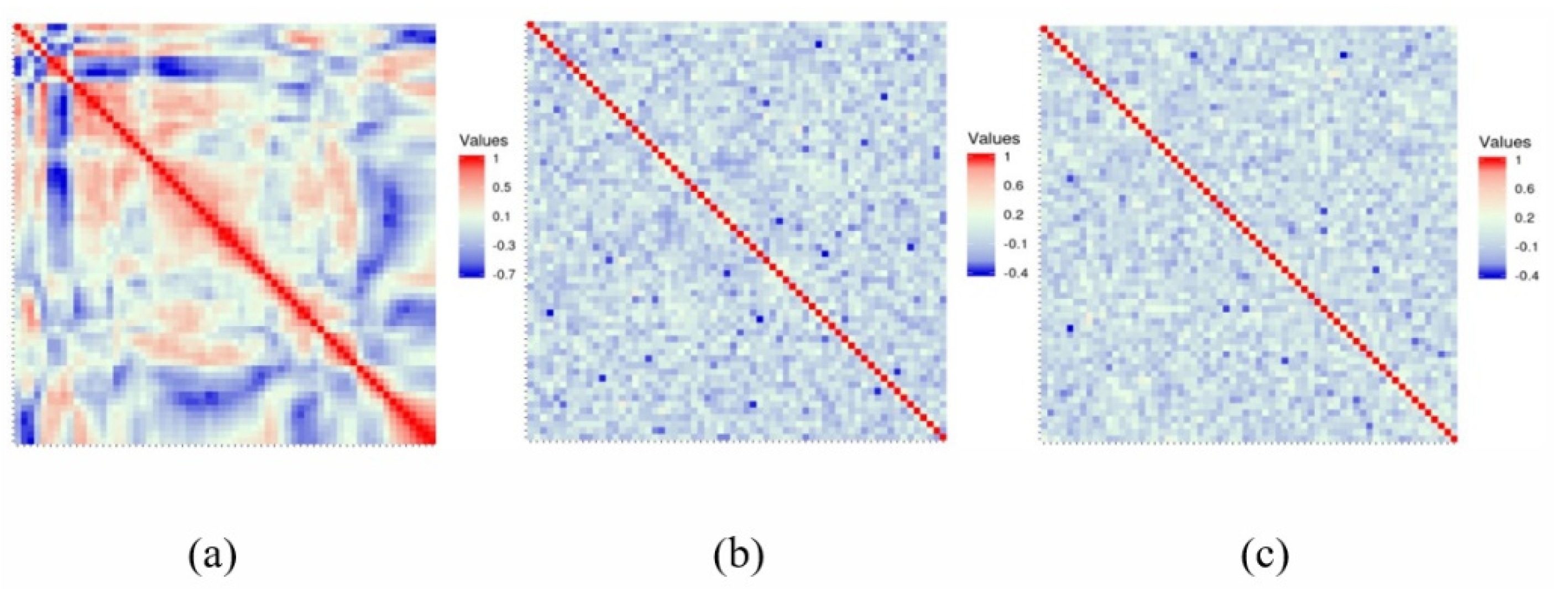1. Introduction
With the development of the Internet and cryptography, communication encryption has attracted the attention of many researchers and has been applied in many fields [
1,
2]. At the same time, the number of images transmitted over the Internet is increasing all the time [
3]. However, they spread through such insecure channels and are easy to be intercepted by some technical means, which leads to the disclosure of many people’s privacy and security problems such as the random modification of digital image information [
4]. In recent years, researchers have proposed many image encryption algorithms, especially those based on chaos, mainly because chaos dynamics have various advantages applicable to cryptography, such as pseudo-randomness, ergodic property, sensitivity to initial values, and controlling parameters. When Fridrich [
5] first applied the structure of permissive diffused junction encryption to image encryption, many chaotic image encryption schemes based on it appeared [
6,
7,
8,
9,
10]; however because the encryption algorithms have security holes, or only use one round encryption, it is extremely vulnerable to be cracked by chosen-plaintext attacks [
11,
12,
13].
Fridrich’s encryption algorithm was broken by Solak [
14], using chosen ciphertext attacks. Hua et al. [
15] proposed a multi-round encryption algorithm, and Yu et al. [
16] solved the linear relationship of the encryption algorithm. No matter how many rounds of encryption are carried out, security loopholes can always be found without being related to plaintext. Li et al. [
17] improved the security of the system through multiple rounds of encryption related to plaintext. In addition, many researchers [
18,
19,
20,
21,
22] sacrifice the efficiency of encryption to obtain encrypted security groups. However, some plaintext-related encryption algorithms [
23,
24,
25] are attacked by chosen plaintext because of the small key space. Therefore, some researchers improved the traditional scramble diffusion structure by combining simultaneous scramble diffusion and cross diffusion [
26,
27,
28] to increase the difficulty of an attack. Nowadays, researchers [
29,
30,
31,
32] integrate the plaintext-related hash function into the encryption algorithm to increase the key space, resulting in the failure of traditional chosen plaintext attacks. The traditional encryption method of the scrambling-diffusion structure becomes more and more complicated.
An image encryption scheme based on a random walk and two hyperchaotic systems is proposed. On the basis of a bit-level encryption scheme, the author has designed a more complex encryption algorithm with randomness and unpredictability. The encryption scheme can be simplified into three stages: the key generation stage, the scrambled stage, and the diffusion stage. In the key generation stage, two pseudo-random sequences are first generated, and are then used to scramble the pixel position in the scrambled stage and the diffusion method to change the pixel value, respectively. Due to the random walk matrix used for the scramble, the initial position and direction of the motion are controlled by the random numbers obtained from the chaotic system, with a significantly better safety performance than other encryption schemes mentioned above.
Our paper analyzes the security of the encryption system, and, through the corresponding theoretical analysis and experimental verification, we find that there are some security loopholes in the original scheme. In this paper, the cryptanalysis of the scheme is carried out, and the attack method is proposed to successfully break the encryption scheme of the original paper. The theoretical analysis and simulation results verify the high efficiency and feasibility of the proposed attack scheme. The special point of this paper is to verify whether the chaotic encryption of multiple random sequences in the scrambled stage and diffusion stage is invalid. The method in this paper can be used to attack and obtain the original image easily. Many papers have used more complex chaotic system generators and more chaotic sequences, but this does not change the security of encryption significantly. We think that the encryption algorithm should be changed to combine the chaotic sequence with the image more closely. Beyond that, the rest of our paper is as follows: The
Section 2 outlines the original encryption scheme. The
Section 3 analyzes its security vulnerabilities and makes preparations. In the
Section 4, the chosen plaintext attack scheme is used for simulation and experiment. In the
Section 5, the algorithm is improved. The
Section 6 analyzes the security of the improved algorithm.
2. Review of the Original Image Encryption Scheme
The flow chart of the original scheme is shown in
Figure 1. In the scheme, the image is first divided into blocks, and is then scramble and diffused. In the scrambled stage, the random walk matrix is generated by a Lorenz chaotic system. The blocks are first scramble internally and then scrambled between blocks, so as to update pixel positions. In the diffusion stage, the chaotic system of the Chen type is used to generate the sequence, and the average pixel is used as the initial diffusion value to encrypt the scrambled image.
2.1. The Secret Key Generation Stage
A chaotic system is used to obtain the key sequences. The hyperchaotic Lorenz system and Chen’s hyperchaotic system are represented by Equations (1) and (2):
where
α = 10,
β = 8/3,
γ = 28 and
η = 1 presents a chaotic state.
where
a = 36,
b = 3,
m = 28,
n = 16, and
k = 0.2 presents a chaotic state.
Note that the variable and constant symbols used in this section represent only the standard generation formula for chaotic systems and do not have the same meaning as the symbols used in the full text.
2.2. Random Walk Matrix
Step 1: Initial keys
x0,
y0,
z0,
w0, by iterating over a hyperchaotic Lorenz system
N0 + 8 ∗
M ∗
N time, to generate several pseudo-random sequences
X,
Y,
Z and
W.
M and
N are the size of the encrypted image, and
N0 is obtained from Equation (3).
where
h is a decimal hash value.
Step 2: The initial position of the random walk (
Px,
Py) is determined by the random sequences
Y and
Z:
Step 3: The direction of the random walk is controlled by
X:
Step 4: According to the initial position and direction, M ∗ N/(m ∗ n) random walk matrices are obtained.
2.3. Scrambling
Scrambling inside blocks: In this stage, the pixel position in each sub-block image is scramble based on the random walk matrix.
For
i = 1, 2, …, (
M ∗
N)/(
m ∗
n) and
j = 1, 2, …,
m ∗
n.
where
B is the sub-block and
L is the sequence obtained by sorting the random walk matrix
A.
Scrambling between blocks: After the scramble of the previous step, a scramble between blocks is adopted; in other words, the pixels of the block are scramble with those of the other blocks.
For
I = 1, 2, …, (
M ∗
N)/(
m ∗
n).
where,
k2 is the sequence obtained after sorting
k1, and
D is the scrambled image.
2.4. Diffusion
The original keys are
x10,
y10,
z10,
w10. By iterating the hyperchaotic Chen system
N0 + 8 ∗
M ∗
N times, four pseudo-random sequences
x1,
y1,
z1, and
w1 are generated, which are merged into two chaotic sequences
X and
Z.
Use
X,
Z chaotic sequences for diffusion:
where
D is the scrambled image and
aver =
Sum(
D)/(
M ∗
N).
3. Cryptanalysis
As is known, Kehoff’s principle of the security of a cryptographic system depends entirely on the key, rather than the complexity of the cryptographic system itself. That is to say, the attacker would know all the information in the original encryption scheme except the secret key. Considering that the cryptographic system proposed by Xu et al. uses a pseudo-random sequence to scramble the image and perform the XOR operation, and although the average value of the image is used as the initial parameter of diffusion, it only carries out one forward diffusion, thus it can be divided into two steps to obtain the plaintext image. The following
Figure 2 shows the attack flow.
3.1. Obtain Diffusion Key
In this section, we discuss how to obtain the keys needed for diffusion. The key generation in the original text has good key space and sensitivity, and because the average value of the image is used as the initial diffusion and the first bit diffusion result is applied to the subsequent diffusion sequence, the diffusion of each image is not the same, and it cannot be obtained simply through the full zero or constant image. However, because of the correlation between the before and after pixel diffusion, we can analyze the diffusion key through the cipher image.
Figure 3 is the flow chart showing how to obtain the key.
In the figure above, we describe the process of obtaining the equivalent diffusion key XY through a flowchart. We found that, when the attacker chose a full zero image such as the plaintext image, since all the pixels in I0 are zero, the plaintext image is not affected by the scrambled process. Therefore, image I0 will be chosen to obtain the corresponding scrambled image D0, which is also going to be a full zero image. Then, the diffusion is used to obtain the ciphertext image C0; thus, the corresponding ciphertext image sequence is obtained, which is the equivalent diffusion key XY. In this way, the scrambled image of any chosen plaintext image can be obtained by diffusion key XY.
The process of obtaining the key is to first construct an image
I0 of full zero pixels, and to obtain the corresponding ciphertext image
C0. If you use a full zero image to encrypt, that means you can skip the scrambled phase and reach the corresponding scrambled matrix
D0. The encryption process uses the addition of two chaotic sequences,
X and
Z, which can be regarded as a chaotic sequence
XY. Therefore, according to the diffusion rule, the key can be obtained by Equation (11).
where,
C0 is the cipher image corresponding to full zero image
D0 and the average
aver of full zero image is also zero.
Thus, it can be further deduced:
After revealing the diffusion key
XY, through the final ciphertext image
C, the attacker only needs to simply perform the XOR and the inverse addition and subtraction operation to obtain the plaintext image. Algorithm 1 describes in detail the process of obtaining the key
XY, and Algorithm 2 is the process of obtaining only scrambled image
D.
| Algorithm 1. Obtain secret key XY. |
Input: full zero image I0
Output: The key XY- 1:
procedure key(I0) - 2:
M, N ← size(I0) - 3:
C0 ← encry(I0) - 4:
XY(1) ← C0(1) - 5:
for i from 2 to M ∗ N - 6:
XY(i) ← bitxor(Ci,Ci−1) - 7:
end - 8:
end procedure
|
| Algorithm 2. Obtain Scrambled images D. |
Input: key XY, cipher image C
Output: Scrambled images D- 1:
procedure Scram(XY,C) - 2:
M, N ← size(C) - 3:
for i from 2 to M ∗ N - 4:
D’(i) ← C(i)⊕XY(i) - 5:
if D’(i) > C(i − 1) - 6:
D(i) = D’(i) − C(i − 1) - 7:
else - 8:
D(i) = D’(i) + 256 − C(i − 1) - 9:
end - 10:
end - 11:
end procedure
|
3.2. Gets the Scrambling Rule
It can be seen from the encryption process in
Section 2 of this paper that the input pixel is scramble twice in the scrambled process; that is, the pixel blocks are scramble inside and between the blocks. However, in a mathematical sense, two-round scramble have exactly the same encryption effect as one-round scramble, as shown in
Figure 4. In other words, no matter how complicated the scramble process is, it simply changes the order of the pixels. For the ordinary image encrypted by this scheme, only two construction matrices can be used to obtain the scrambled rules. Color images or greater images only need to add an extra choice matrix in this changed extension.
In this section below, our main goal is to attack the scrambled phase of the original encryption scheme. In this step, as long as the scrambled image D is restored to the normal image I before scramble, the original password system is successfully attacked. It is important to note that any existing scrambled algorithm only changes the position of the pixel, not the value of the pixel, which allows an attacker to test the image to obtain a scrambled rule. Therefore, the key point is that, as long as we can find the original position and the new position of each pixel of the original image after the scrambled stage, we can obtain the equivalent scrambled matrix H, thus successfully breaking the scrambled stage of the original cipher system.
We chose a 256 × 256 plaintext image and can use two pairs of specially selected plaintext images to obtain the value of n, as follows:
Considering that the original cryptographic system uses two scrambling, the final scramble can be regarded as the corresponding position obtained by one scramble. We define two marker matrices to mark the position of each pixel of the ordinary image by Equations (1) and (2):
The size of
m1 and
m2 is 256 × 256. First, the two marker matrices are encrypted to obtain the corresponding encryption graphs
Cm1 and
Cm2. However, when the corresponding scrambled map is obtained through the diffusion secret key
XY, it is necessary to take into account the average
aver of
Cm1 and
Cm2 after the encryption of
m1 and
m2, which is replaced by
f1 and
f2, respectively. It can be obtained through the following formula:
When the constructed matrices
m1 and
m2 are used to obtain the scrambled graph through diffusion matrix, the following formula is needed to obtain the first pixel bit of
Om1 and
Om2 of the scrambled graph:
Next, Algorithm 3 is used to encrypt image
Cm1 and
Cm2 to obtain scrambled matrix
Om1, except the first pixel, and all remaining pixels of
Om2. After obtaining the scrambled graphs of the two marker matrices,
m1 and
m2, we can obtain the relative scrambled position of the ciphertext image
C by an equivalent scrambled matrix
H. However, first, the pixel ranges of two scrambled images
Om1 and
Om2 are converted into a matrix of 65,536 possible pixel positions. The following formula can be used:
Thus, we can obtain the scrambled position of each pixel from 1 to 65,536; that is, shrink it from any possible pixel position to correspond to the original pixel one by one, so as to accurately determine the unique scrambled position of the original ordinary image. The specific algorithm is Algorithm 3.
| Algorithm 3. Obtain the permutation rule H. |
Input: Select the image m1,m2, key XY
Output: permutation rule H- 1:
procedure Rule(m1, m2) - 2:
M, N ← size(C) - 3:
Cm1, Cm2 ← encry(m1, m2) - 4:
Om1, Om2 ← Algorithm 2(Cm1, Cm2) //Obtain Scrambled images - 5:
for i from 1 to M - 6:
for j from 1 to N - 7:
H(i,j) ← 256 ∗ Om1 (i,j) + Om2 (i,j) - 8:
end - 9:
end - 10:
end procedure
|
3.3. Restore Plaintext Image
Because the original plaintext image I is diffused when the first pixel diffuses, aver is used to obtain encryption C. Unlike the aver used for the original plaintext image I, this results in the diffuse value being an unknown pixel value. But subsequent diffusion is an aver independent process, so we can temporarily set the first pixel value of the original image to the unknown number xfirst. After the diffusion reduction of XY chaotic sequence, only scrambled matrix D is obtained, and then the equivalent scrambled matrix H is used. D is restored to the image Ip except the first pixel value. Finally, xfirst is solved and restored to the corresponding position of the original image. In other words, plaintext image can be restored.
Since the diffusion sequence
XY and the scrambled rule have been obtained, it is easy to obtain the plaintext image
Ip except the first one. The specific recovery process is shown in
Figure 5, which will not be described in detail here. The following is the specific process of finding the first pixel
xfirst.
The
aver of the original plaintext image
I is as shown in the following formula:
When the original encryption system encrypts, the cipher image encrypted by plaintext
I is
C, which can be transformed into the following equation:
At this point,
C(1) in the original cipher image
C is known. After the previous steps, the chaotic sequence can be obtained as
XY. Let us assume the first pixel value
xfirst and convert it into:
According to the previous steps, we have obtained all pixel values except
xfirst, then we can know that
aver is also equal to:
From Equations (21) and (22), we can obtain two formulas to get the value of
xfirst and combine them, as shown in Equation (23):
Figure 6 shows the result of the chosen plaintext attack to obtain only scrambled images. In
Figure 6, the first column is the plaintext image, the second column is the final ciphertext image, and the third column is the resulting only scrambled image.
Figure 6(a1,b1) shows two different selected plaintext images;
Figure 6(a2,b2) is the final ciphertext image of the plaintext image in
Figure 6(a1,b1) after the original encryption scheme.
Figure 6(a3,b3) is the only scrambled image obtained after decrypting the final ciphertext image
Figure 6(a2,b2) using the diffusion key XY shown above. As long as a unique scrambled image is obtained, the original position can be restored by mapping, and the scrambled rules can be obtained to find the original plaintext image, as described above. In addition, in this section, we use an element that marks a particular pixel position (1,1) of the original plaintext image to restore the x value.
Figure 7 shows the histogram display of the scrambled image of the original image. From the perspective of the result, the pixel value is consistent with that of the original image, which proves that the scrambled image of the original image is successfully obtained.
3.4. Summary
The detailed process is shown in the following steps:
Step 1: Determine the number of chosen plaintext images by Equation (12) and construct the equivalent key
XY by selecting the plaintext image, as shown in
Figure 3, so as to obtain the scrambled image
D of the original cipher image
C.
Step 2: Next, obtain the scrambled images Om1 and Om2 corresponding to the chosen plaintext m1 and m2 by the equivalent key XY. Algorithm 3 is used to obtain the equivalent scrambled matrix H corresponding to the original scrambled stage. After recording the scrambled operation, select the new pixel position of each line of the plaintext image m1 and m2.
Step 3: By scrambling the matrix H equivalently, obtain the plaintext image C of the only scrambled image D.
Step 4: Finally, the plaintext image I corresponding to the cipher image C is obtained by calculating the value of the pixel in the original position scramble by the first pixel of the image Ip.
In addition, the simulation experiments were carried on a personal computer equipped with an Intel Core i5-10210U 2.11GHz CPU and 16 GB memory capacity, which verifies the effectiveness and feasibility of the proposed attack scheme. Matlab software R2020a was used in the simulation experiments. In order to prove the feasibility and correctness of our scheme, we used the same initial and control parameter values to carry out the simulation experiments. The proposed algorithm can successfully attack all kinds of grayscale images encrypted by the original cryptographic system, and the average usage time is 12.4573 s. We use the size of 256 × 256 ordinary images for simulation experiments, including the size of 256 × 256 “Lena” image, the size of 256 × 256 “Airfield” image, the size of 256 × 256 “Dollar” image, and the size of 256 × 256 “Pepper” image. All test images were from the USC-SIPI image database. The experimental results are shown in
Figure 8.
4. Improvement
In the original encryption scheme, the diffusion is carried out according to the XOR result of the former bit, but the diffusion result of the former bit is exposed in the cipher image, therefore it is very insecure. In order to hide the relationship between diffused pixels, two-way diffusion can be adopted. Without changing the original scheme secret key and encryption framework, forward diffusion and backward diffusion are carried out through two chaotic sequences
X1(
i) and
Y1(
i) to improve security, as shown in
Figure 9.
Step 2: The chaotic sequence is obtained according to Equation (2):
X1(
i),
Y1(
i).
Step 3: Forward diffusion:
where
D is diffusion result, and
C is a matrix of forward diffusion.
aver =
Sum(
D)/(
M ∗
N),
i = 2, 3, 4, …,
M ∗
N.
Step 4: Backward diffusion:
where
C is the forward diffusion result,
T represents the backward diffusion result,
p =
M ∗
N,
i =
p − 1,
p − 2,
p − 3, …, 1.
5. Performance of the Improved Cryptosystem
In this section, the experimental results are given and the performances of the improved cryptographic system are analyzed. Here, we obtain the normal image from the USC-SIPI image database. In addition, other size images can also be effectively encrypted by the proposed algorithm, which is not tested very much in this paper.
We tested the improved encryption method in the following five parts: Histogram Analysis, Correlation Analysis, Information Entropy Analysis, Differential Attack Analysis, and Computational and Complexity Analysis. Since the chaotic sequence used in this paper and the generated key belong to the original encryption scheme and have undergone a lot of tests, the randomness of the sequence and the key space are not tested here.
5.1. Histogram Analysis
Histogram analysis can be very intuitive to observe the distribution of pixels. A good encryption method, its histogram inevitably shows the characteristics of pixel homogenization. Compared with the original scheme, the improved scheme inherits the advantages and improves the security.
Figure 10 shows the result of the original encryption scheme and the improved scheme. (a1) Represents a plaintext image and (b1) is the corresponding histogram; (a2) represents the original encryption image and (b2) is the corresponding histogram; (a3) represents the improved encrypted image and (b3) is the corresponding histogram. It can be seen from the histogram that the improved scheme has better chaos. We verified the visual uniformity by calculating the histogram variance. The histogram of the original scheme has a pixel variance of 311.5029, and variance after improvement is 276.2195. Obviously, the improved scheme has a smoother distribution in the histogram.
5.2. Correlation Analysis
The pixels of ordinary images usually have high neighborhood correlation, which can be weakened by the encryption algorithm. In addition, better algorithms lead to weaker correlations. The correlation between the adjacent pixels of the plaintext image and the ciphertext image is compared, and the results are shown in
Figure 11,
Figure 12 and
Figure 13. The correlation heat map of the images is shown in
Figure 14. Relative to the correlation, the improved algorithm is comparable with the original one.
According to the experimental analysis,
Table 1 shows the image correlation coefficients obtained by different algorithms. When the correlation coefficient of the ordinary image approaches 1, and the correlation coefficient of the encrypted image approaches 0, then we can consider that it has a good encryption effect. It can be seen from
Table 1 that the coefficients of the improved algorithm approach 0 infinitely in horizontal, vertical, and diagonal directions. As can be seen from the above experimental results, the improved algorithm can break the correlation between adjacent pixels through encryption. In
Table 1, we select four images for correlation analysis, and the horizontal and vertical coefficients in most images are reduced. Although the diagonal direction of some images did not decrease, the average value is smaller as a whole.
5.3. Information Entropy Analysis
In the field of image encryption, information entropy is an important index to reflect the randomness of information. A good secure cipher image has great statistical randomness and information entropy. The standard of information entropy is 8, which means that, when the password image is close to this value, its distribution is approximately random. Therefore, different encryption algorithms will obtain different information entropy; of course, the same algorithm will change due to different images. The experimental results are shown in
Table 2. The information entropy of all encryption algorithms is close to 8, and they all pass the randomness test. The average entropy of the four images is 7.9968, which is an acceptable standard error.
5.4. Differential Attack Analysis
Resistance to differential attacks is another security criterion, and its ability lies in the sensitivity of ordinary images to change. In other words, if the encrypted algorithm is sensitive to changes in pixel values, it is well resistant to differential attacks. In order to test the ability of the improved algorithm, the following representative images were selected and the pixels in them were randomly selected to obtain the average value. As shown in
Table 3, NPCR values were close to the ideal value (99.6094%), and UACI values ranged from 33.3% to 33.6%. It can be seen from the table that there is not much difference in the ability of the two encryption schemes to resist differential attacks. Therefore, changing one pixel in the ordinary image will affect almost all of the pixels in the cipher image, which shows that the scheme has better security against differential attack.
5.5. Computational and Complexity Analysis
In
Table 4, we conducted experiments on the original encryption algorithm and the improved algorithm and obtained their encryption execution time, and the execution environment is shown in
Section 3. In order to improve the accuracy, we encrypt different natural images several times and use the difference methods to obtain the average value for comparison. In addition, when the improved algorithm is executed under different images and environments, the execution time is almost the same as that of the original scheme.
6. Conclusions
The encryption scheme based on the random walk and hyperchaotic system has the advantage of the average value of pixels related to plaintext, which can be used as the diffusion basis to resist the general attack scheme. However, our proposed method can effectively break the encryption mechanism. The experimental results verify the effectiveness of cryptanalysis, and the execution speed also meets the requirements. Therefore, in order to improve the security of the encryption method, we give the improved diffusion course. The key space and number are the same as the original scheme, and the execution efficiency of the algorithm is almost the same as that of the original scheme, but it greatly improves the security of the cryptographic system. From the experimental results, the encrypted image of the new algorithm is sufficiently chaotic. However, the encryption method in this paper is not just to prove that it is more chaotic than other methods or has higher performance. Note that the key to this article is hard-to-crack security. Compared with the XOR of the original algorithm, this paper applies two-step diffusion to all pixels from beginning to end, and uses another chaotic sequence to reverse diffusion, which gives the new algorithm an order of magnitude more security than the original method. Therefore, it can be concluded that the improved scheme is superior to the original encryption scheme and is comparable other similar schemes.
Of course, although the algorithm in this paper improves security, it also has some disadvantages; for example, it also slightly increases the processing time, and with the image size increases, the running time difference also expands. Our future research direction is to, on the basis of the chaos and security of this paper, improve the performance, so that the operation speed of encryption is faster and the time complexity is lower.
